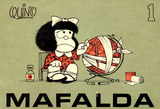
A sample culminating writing/art/all-around creative project for world language classrooms!
- Subject:
- Education
- Language Education (ESL)
- Languages
- Material Type:
- Assessment
- Author:
- Mariah Villaroman
- Date Added:
- 04/25/2020

A sample culminating writing/art/all-around creative project for world language classrooms!

Creative Translation for Real-World Contexts is one of the first translation textbooks designed for Spanish/English speakers at an intermediate-high (B2) level. This book introduces students to the basic ideas of translation while addressing frequent pain points that recur when working bidirectionally. Additionally, a focus is placed on fostering metacognitive skills by encouraging creative translation from real-world environments such as narration, business, advertising, specialized contexts (including inclusive and queer language), and in situations when there are no clear translations available, such as sci-fi and fantasy works. Chapters alternate between Spanish and English as the languages of discussion, thus providing an equitable challenge for native speakers of both languages.
Please let us know if you adopt this book here: https://bgsu.az1.qualtrics.com/jfe/form/SV_2hlHnf1OcdYrkI6

Middle school is a conflict-ridden stage, particularly for our emerging bilingual students, who are normally known as ELLs. Not only do they have to overcome numerous problems of linguistic and cultural adaptation, but they also have to face challenges such as family or economic instability and moves, often cross-border. Indeed, it is not uncommon to meet Hispanic students: Mexicans, Puerto Ricans, Salvadorans, etc. who travel to their countries of origin, or to the countries of origin of their parents for seasons, sometimes even to stay and live there, despite having been born in the United States and having lived here all their schooling until that moment. It is also quite common to see students who migrate with their families to the United States when they are already 11 or 12 years old and who, as we mentioned, not only have to learn the language, but adapt to a new life, culture and traditions.In this lesson plan we propose to use these personal experiences to introduce basic conversational vocabulary. It is designed for both dual immersion programs and English development classes.

This OER Lesson plan/unit was created by Danielle Fulcher as part of the 2023 World Language OER Summer work and training. Educators worked with NDE staff to create OER Learning Plans and materials. The attached Lesson Plan is designed for 9 - 12 World Language Arts teachers for student learning of Novice-Mid Learners of Spanish. This is a lesson to introduce the concept of culture to novice level Spanish students. Using the analogy of the "cultural iceberg" students take a closer look at what culture is and to which cultures they belong. We go further by taking a look at greetings in their own culture and comparing them to greetings in Spanish-speaking countries. Students are able to define what a typical greeting looks like and what influences how those greeting rituals look on the surface. This resource comes with a pdf of a slideshow with information and a pdf worksheet for your students to analyze the concept of culture.This Lesson Plan addresses the following NDE World Language Standard(s): NE WL 2.1.b, 2.2.bIt is expected that this Lesson Plan will take students 50 minutes to complete.
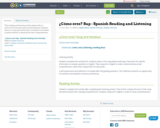
This reading and listening activity aligns well to a novice-level unit about personal descriptions. Students listen to a song and read its lyrics. A handout is included to guide students to demonstrate their comprehension.
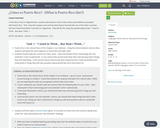
In this face to face or flipped lesson, students will examine some of the culture and traditions associated with Puerto Rico. Then, they will compare and contrast what they've learned with one of the other countries we have researched (either Costa Rica or Argentina). They will do this using the questioning prompt, "I Used to Think... But Now I Think...".(ACTFL Standards: Cultures - 2.1 & Comparisons - 4.2)

Spanish translation of CK-12 Conceptos de Ciencias de la Vida - Grados 6-8 - en Español. This segment describes the destruction of habits. The following concepts are evident: participles used as adjectives, present perfect, impersonal se, use of mente to create adverbs. Vocabulary used includes scientific cognates and ecology.

El Dia de los Muertos is a Mexican celebration, it is a day to celebrate, remember and prepare special foods in honor of those who have died. There is one day dedicated to the children who have died and one day dedicated to adults. This lesson is designed for Spanish classes in Middle School to learn about the customs and traditions of Meso-American people.Each student does research at stations to find answers to questions that give the students an overview of Day of the Dead traditions. After the research is completed each sttudent has the opportunity to complete crafts that are centered around the two-day celebration. Customarily, the Spanish teacher will then display the craft products in the classroom since the lesson is usualy conducted around Dia de los Muertos.

Presentaciones del curso Español I del Colegio Universitario de San Juan (Puerto Rico).
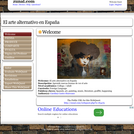
This WebQuest has a double focus, spanish language and Spanish Art content. It aims at making students reflect on the very nature of art taking examples from Spanish contemporary art, and also at improving Spanish language skills and art vocabulary. It promotes creativity, critical thinking, cooperative learning and uses web 2.0. tools.

In this lesson, students learn the importance of migratory hummingbirds and how to help them face the impacts of climate change.
Step 1 - Inquire: Students listen to a legend about a hummingbird from the Nasca culture in Peru and wonder about the events in the story.
Step 2 - Investigate: Students explore the diversity of hummingbirds in North America and imagine the life of the ruby-throated hummingbird as it faces the impacts of climate change.
Step 3 - Inspire: Students reflect on efforts to support hummingbirds in Mexico and create an imaginative response of their own.
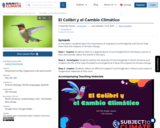
SYNOPSIS: In this lesson, students learn the importance of migratory hummingbirds and how to help them face the impacts of climate change.
SCIENTIST NOTES: This lesson teaches students all about hummingbirds. Hummingbirds are important pollinators, and climate change is hurting their habitat. This lesson passed the scientific review process.
Esta lección enseña a los estudiantes todo sobre los colibríes. Los colibríes son polinizadores importantes y el cambio climático está dañando su hábitat. Esta lección pasó el proceso de revisión científica.
POSITIVES:
-This lesson encourages students to look for hummingbirds in their local environment and feel connected to the natural world and their neighboring country, Mexico.
-The lesson exposes students to the diversity of Indigenous peoples in the Americas through Indigenous language names for hummingbirds in Mexico and the stories from three different Indigenous cultures.
-This lesson could connect with a Day of the Dead lesson by beginning with the video of the Aztec legend about the relationship between the cempasúchil flower and the hummingbird.
ADDITIONAL PREREQUISITES:
-The main species in this lesson, the ruby-throated hummingbird, is currently abundant. In fact, climate change may extend the range of this species farther north as the climate becomes hotter. Students have a high probability of encountering this hummingbird in New Jersey and thus appreciating its tenacity and beauty.
-Appreciating the local migratory hummingbird can help students understand the concept of interdependence within communities and across borders.
-Understanding interdependence and fomenting cross-cultural cooperation are important aspects of finding solutions to climate change.
-Other species of hummingbirds, as noted on the poster from CONABIO, are more acutely threatened by climate change. Students can discuss why. For example, the more a hummingbird depends on an endemic species of plant (a plant found only in its region) or a more specific microclimate, the more vulnerable it is to disruption from climate change.
-Teachers can use this resource from Rutgers to further their understanding of the ruby-throated hummingbird.
DIFFERENTIATION:
-Teachers can use all the activities in the lesson or choose activities that are most apt for their class.
-Teachers should preview the videos that tell stories about hummingbirds from the Nasca culture and the Aztec culture. These stories include events that students may find sad or scary. For example, the Aztec story includes the death of a warrior whose soul becomes the hummingbird. Students can talk about how they and the characters feel at different moments.
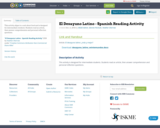
This activity aligns to a unit about food and is designed for intermediate students. Students read an article, then answer comprehension and personal reflection questions.
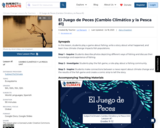
In this lesson, students play a game about fishing, write a story about what happened, and learn how climate change impacts fish populations.
Step 1 - Inquire: Students describe photos depicting different ways of fishing and discuss their knowledge and experience of fishing.
Step 2 - Investigate: Students play the fish game, a role-play about a fishing community.
Step 3 - Inspire: Students make connections between a news report about climate change and the results of the fish game and create a comic strip to tell the story.

In this lesson, students play a game about fishing, write a story about what happened, and learn how climate change impacts fish populations.
Step 1 - Inquire: Students describe photos depicting different ways of fishing and discuss their knowledge and experience of fishing.
Step 2 - Investigate: Students play the fish game, a role-play about a fishing community.
Step 3 - Inspire: Students make connections between a news report about climate change and the results of the fish game and create a comic strip to tell the story.
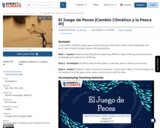
SYNOPSIS: In this lesson, students play a game about fishing, write a story about what happened, and learn how climate change impacts fish populations.
SCIENTIST NOTES: In this lesson, students play the Fish Game to investigate sustainable fishing practices. This lesson passes our scientific review process.
En esta lección, los estudiantes juegan El Juego de Peces para investigar prácticas de pesca sostenible. Esta lección pasa nuestro proceso de revisión científica.
POSITIVES:
-This lesson includes hands-on, student-led communicative tasks and an authentic Spanish language listening activity.
-The fish game allows students to practice their extemporaneous speaking skills while learning about the impact of decision-making on communities.
-By playing the fish game, students encounter the economic, ecological, and social challenges of sustainable fishing.
ADDITIONAL PREREQUISITES:
-This is Lesson 1 of 3 in our Cambio Climático y la Pesca unit.
-This lesson is meant for students with an intermediate-low Spanish language proficiency level. However, novice-high level students can play the game by using the support materials in the Differentiation section below.
-Teachers can use paper clips or scraps of paper to represent the fish in the game to help students visualize their “catches” and the fish remaining in the lake.
DIFFERENTIATION:
-Students who need a review of basic grammatical concepts can complete the Grammar Review before playing the game.
-Students with novice-high proficiency levels can use the useful phrases included at the end of the El Juego de Peces Student Packet to help them interact in Spanish during the game.
-The tira cómica activity in the Inspire section can be modified to incorporate advanced grammar, such as the use of past tenses or the present tense subjunctive.
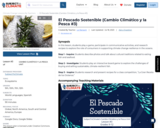
In this lesson, students play a game, participate in communicative activities, and research recipes to explore the role of consumers in supporting climate change resilience in the oceans.
Step 1 - Inquire: Students describe photos and talk about cultural traditions related to eating fish and seafood.
Step 2 - Investigate: Students play an interactive board game to explore the challenges of buying and selling sustainable, climate-resilient fish.
Step 3 - Inspire: Students research and present recipes for a class competition, “La Gran Receta de los Océanos.”
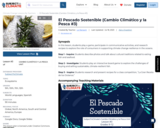
SYNOPSIS: In this lesson, students play a game, participate in communicative activities, and research recipes to explore the role of consumers in supporting climate change resilience in the oceans.
SCIENTIST NOTES: Many people use fish as their primary source of protein. But climate change is hurting fish populations and the people who need them. This lesson has passed our scientific review process.
Muchas personas utilizan el pescado como fuente principal de proteínas. Pero el cambio climático está perjudicando a las poblaciones de peces y a las personas que los necesitan. Esta lección ha pasado nuestro proceso de revisión científica.
POSITIVES:
-Students participate in a variety of communicative activities and are exposed to authentic resources from Spain and Latin America.
-The post-game reflection allows students to make personal connections to the ideas in this lesson and reflect on cultural and social justice themes.
-The recipe competition is motivating and allows for student voice and choice.
-Since most activities are completed independently, this lesson can be used for substitute plans.
ADDITIONAL PREREQUISITES:
-This is lesson 3 of 3 in our Cambio Climático y la Pesca unit.
-This lesson can be used as a standalone lesson or added to units on food, shopping, the environment, global challenges, science, technology, or contemporary life.
-Students with intermediate-low proficiency will be able to successfully navigate the activities in this lesson.
-Students should have a general familiarity with vocabulary and concepts related to climate change and fishing.
DIFFERENTIATION:
-As an alternative to the video in the Investigate section, teachers can print out MarViva's Guía de Trazabilidad and place the pages around the room. Students can walk around the room and take notes on the recommendations in the guide.
-The teacher can project the game board and students can play the game as a class instead of in pairs or small groups.
-Students can create personalized lists of vocabulary with expressions from this lesson to practice on a platform like Quizlet.
-Students can create a local guide in Spanish about where to buy sustainable seafood or write an article in Spanish for the school newspaper.
-Advanced classes can begin the lesson by analyzing Pablo Neruda’s poem “Oda al Caldillo de Congrio” instead of describing the photos.
-After completing this lesson, AP Spanish Language and Culture students can record a two-minute cultural comparison using one of these prompts:
-¿Cómo ha afectado el cambio climático la vida de las personas en tu comunidad? ¿Qué hacen para expresar solidaridad los miembros de tu comunidad?
-¿Qué hábitos o actividades se consideran una expresión de los valores en tu comunidad? ¿Qué opinión tienen las personas en tu comunidad con respecto a los avances en la ciencia y la tecnología?
-¿Qué papel juegan las tradiciones de la comida en las familias de tu comunidad? ¿Qué importancia tiene el trabajo en el bienestar de las familias en tu comunidad?
-As a culminating activity for this three-lesson unit, the class can watch this Youth for Sea music video and then create their own version of the video or create graphics to go with the song.
-The class can come up with their own criteria, based on the lesson, for the competition “La Gran Receta de los Océanos.”
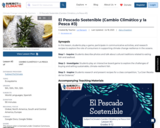
In this lesson, students play a game, participate in communicative activities, and research recipes to explore the role of consumers in supporting climate change resilience in the oceans.
Step 1 - Inquire: Students describe photos and talk about cultural traditions related to eating fish and seafood.
Step 2 - Investigate: Students play an interactive board game to explore the challenges of buying and selling sustainable, climate-resilient fish.
Step 3 - Inspire: Students research and present recipes for a class competition, “La Gran Receta de los Océanos.”
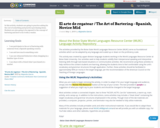
In this activity, students are going to practice asking for the cost of something and practice purchasing items. Students are also going to be exposed to the concept of bartering and how to do it with a vendor.